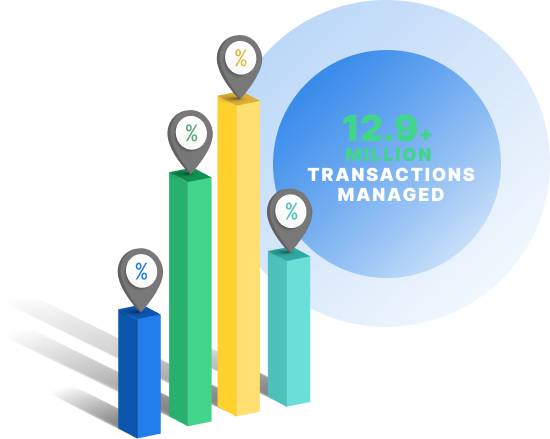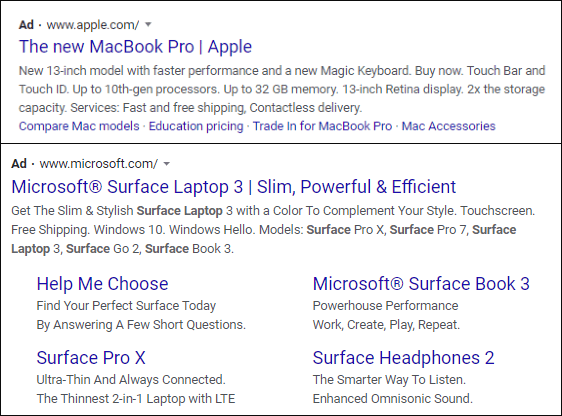-
 8 min. read
8 min. read
-
 Macy Storm
Macy Storm Senior Content Creator
Senior Content Creator
- Macy is a marketing writer with over five years of experience creating content for dozens of industries including food and beverage, home services, and education. She also specializes in creating SEO and PPC content. Her work has been featured by Search Engine Journal, HubSpot, Entrepreneur, Clutch, and more. In her free time, Macy enjoys trying new crafts and reading comic books.
What is the difference between sales and marketing?
The difference between sales and marketing is this: the marketing team focuses on sparking interest in products and services, while the sales team encourages target audiences to convert. Essentially, marketing is the first step to getting leads interested, while sales take that interest and nurture it into a loyal customer.
You hear people say that you should focus on sales and ramping up your sales team to reach prospects. Other people will tell you to focus on building your marketing strategy to reach prospects.
On this page, we’ll answer questions like:
- What’s the difference between sales and marketing?
- Should I focus on sales or marketing?
- How can I use sales and marketing together?
Keep reading to learn more about the difference between sales and marketing. To get the latest marketing tips, subscribe to Revenue Weekly!
Sales vs. marketing: The breakdown
Let’s take a further look into how sales and marketing differ.
| Factor | SALES | MARKETING |
|---|---|---|
| Process | Focus on sales process, how to interact with customers, how to answer questions, and provide relevant information | Focus on explaining what the product or service is, how much it costs, who is most likely to be interested, and where you can reach those users |
| Goals | Hitting sales goals or quotas | Promoting your product, company or brand, communicating its value, and attracting leads or earning sales via marketing efforts |
| Strategies | Phone calls, networking, promotional events | Paid ads, social media, SEO |
| Prospects | Working with known prospects | Obtaining new prospects |
Process
The processes of sales and marketing is slightly different.
Think of marketing as the precursor for the sales team. With the marketing process, you establish basic information like who you are, what you offer, and how much it costs. You establish your brand and showcase what you have to offer your audience, and you explain how you can solve their problems and the pain points you address.
In the sales process, you focus on taking the information your audience already has and trying to provide them with additional information, as well as answer any questions.
You focus on providing strong selling points, personalized solutions, and making pitches to convince leads to convert.  Grammarly offers a great example of a sales-focused page. They have a chart that highlights all the extra features you get by getting Grammarly Premium, which serve as strong selling points for the company.
Grammarly offers a great example of a sales-focused page. They have a chart that highlights all the extra features you get by getting Grammarly Premium, which serve as strong selling points for the company.
Additionally, they include stats at the bottom that showcase why people love their product.
Goals
When you look at marketing vs. sales, you’ll find the goals are slightly different.
With sales, your focus is on earning conversions. Your sales team works on nurturing prospects towards becoming customers.
Marketing goals are slightly different. While marketing can focus on sales, its main goal revolves around promoting your company, product, service, or brand and communicating its value.
Communicating this value does help you earn sales, but you need to establish brand trust through marketing first.
Strategies
When you look at the difference between marketing and sales, you’ll notice the strategies are different.
Sales strategies focus on making direct contact and connections with your prospects. You use strategies like phone calls, promotional events, and networking to try and engage prospects to get them to convert. These are known as outbound strategies because you reach out to prospects.
Marketing strategies, on the other hand, focus on getting prospects to reach out to you.
You use strategies like paid ads, social media, and SEO to get prospects to reach out to you about your products or services. These are known as inbound marketing strategies because the leads come to you.
Prospects
Another difference between marketing and sales are prospects.
With sales, you know your prospects. You know who’s interested in your products or services, from their name to their phone number, so you can quickly contact them and provide them with information to sell them further on your business.
Marketing, on the other hand, focuses on obtaining new prospects.
You have an idea of who is in your target audience, but you don’t know the specific people. Marketing focuses on reaching those most interested so that you can turn them into prospects for your sales team.
Time to Level Up Your Sales
Our long list of services helps you grow every aspect of your business with marketing strategies that are proven to increase bottom-line metrics like revenue and conversions.
In the past 5 years, we’ve managed more than 14.9 MILLION transactions across our client base.

Should I focus on sales or marketing?
The debate shouldn’t be about marketing vs. sales and which one deserves your attention more. Instead, the focus should be on how to use sales and marketing together to help your business thrive.
The lines between sales and marketing have become blurry.
Marketing helps jumpstart the process of earning prospects, while sales teams turn those prospects into customers. It’s challenging to have one without the other.
You need a blended strategy to maximize sales for your business.
How do I create an effective marketing and sales strategy?
Now that you have the answer to “What’s the difference between marketing and sales?” and you see how these strategies differ, it’s time to focus on using sales and marketing together to maximize revenue for your business. Here are four tips for creating an effective marketing and sales strategy:
1. Make sure you know your market
First, to have a successful sales and marketing strategy, you need to know who’s in your target market.
It’s essential to establish this information, so your marketing team knows who to target, and your sales team understands your target market enough to provide them with the information they need. To establish your target market, look at your typical customers.
You’ll want to look at the characteristics they share. You should include information like:
- Age
- Gender
- Occupation
- Family status
- Income
- Buying Habits
- Hobbies
- Interests
- Pain points
- And more
Having a basic profile for your customers will help you know who you’re trying to reach and how you can reach them best. It enables your sales and marketing team to provide the best information for your audience.
2. Establish your position in your market
To help you have a cohesive sales and marketing strategy, you need to establish your position in your market.
What do you offer, and why is your business the best choice? It’s good to establish this information so your marketing and sales team delivers a consistent message about your products or services. It helps you establish your brand identity and identify what makes you unique from your competition.
Apple and Microsoft are great examples of this concept.
When you compare their ads, you can see how they position themselves in the market and what they choose to focus on to get people to purchase their products.  When you know your position in your market, you can leverage it to engage more prospects.
When you know your position in your market, you can leverage it to engage more prospects.
So, for example, if you’re one of the top-rated insurance companies in your area, you can market that information to your prospects. Then, your sales team can follow up with information that shows why you’re a top-rated insurance company.
When you know where you stand in your market, you can create a more effective marketing strategy and help your sales team make more persuasive pitches.
3. Verify pricing
Janet is browsing your website. She’s been eyeing up your software after seeing ads for it and reading some content on your site. She sees you’re offering a limited time discount for first-time subscribers.
Excitedly, Janet calls your sales team to get more information.
When she asks about the price, the sales team reads her the full price for new customers. Now Janet’s confused — is the software really on sale? This scenario can happen if you’re not consistent with pricing across your marketing and sales teams.
If you decide to have a discount on your prices or add a bonus, you need to notify both your marketing and sales team.
It’s essential to keep your teams up to date on any changes and prices. If your sales team gives out the wrong prices or numbers, it can make prospects feel less confident in your business.
Always verify that both teams have the most accurate pricing information to ensure everything operates smoothly.
4. Keep both teams informed
Keeping your sales team up to date with pricing and sales is just the beginning.
A strong sales and marketing strategy works to keep both parties informed. When your marketing team runs campaigns, your sales team should know what type of campaigns you’re running. Some prospects may call them and mention the campaigns.
If your sales team knows the campaigns, they can make an immediate connection to the information the prospect saw.
It also helps your sales team stay consistent with its messaging.
So, if you’re advertising a sale with your PPC ads, your sales team should know about it, so they can reaffirm the information.
Your sales team should also keep your marketing team informed. Since they engage with prospects one-on-one, they know what works and what doesn’t work for leads. They should relay this information to your marketing team to help create campaigns that appeal better to your target audience.
A strong exchange of information between teams will help you market better and sell more.
Our digital marketing campaigns impact the metrics that improve your bottom line.
See More Results
WebFX has driven the following results for clients:
$6 billion
In client revenue
24 million
Leads for our clients
7.14 million
Client phone calls
Get help with your sales and marketing strategy today
The difference between marketing and sales gets blurrier by the minute.
Sales and marketing can quickly become a single unit that helps you deliver the right information to prospects and get them to convert. Are you feeling overwhelmed with trying to create a cohesive strategy?
WebFX can help. With Nutshell software, we can help you seamlessly combine your sales and marketing strategy to create a more cohesive campaign.
From tracking the return on investment (ROI) of your marketing campaigns to managing your sales pipeline, we can help you do it all!
Give us a call today at 888-601-5359 or contact us online to speak with a strategist!
-
 Macy is a marketing writer with over five years of experience creating content for dozens of industries including food and beverage, home services, and education. She also specializes in creating SEO and PPC content. Her work has been featured by Search Engine Journal, HubSpot, Entrepreneur, Clutch, and more. In her free time, Macy enjoys trying new crafts and reading comic books.
Macy is a marketing writer with over five years of experience creating content for dozens of industries including food and beverage, home services, and education. She also specializes in creating SEO and PPC content. Her work has been featured by Search Engine Journal, HubSpot, Entrepreneur, Clutch, and more. In her free time, Macy enjoys trying new crafts and reading comic books. -

WebFX is a full-service marketing agency with 1,100+ client reviews and a 4.9-star rating on Clutch! Find out how our expert team and revenue-accelerating tech can drive results for you! Learn more
Try our free Marketing Calculator
Craft a tailored online marketing strategy! Utilize our free Internet marketing calculator for a custom plan based on your location, reach, timeframe, and budget.
Plan Your Marketing Budget

Maximize Your Marketing ROI
Claim your free eBook packed with proven strategies to boost your marketing efforts.
Get the GuideTry our free Marketing Calculator
Craft a tailored online marketing strategy! Utilize our free Internet marketing calculator for a custom plan based on your location, reach, timeframe, and budget.
Plan Your Marketing Budget





